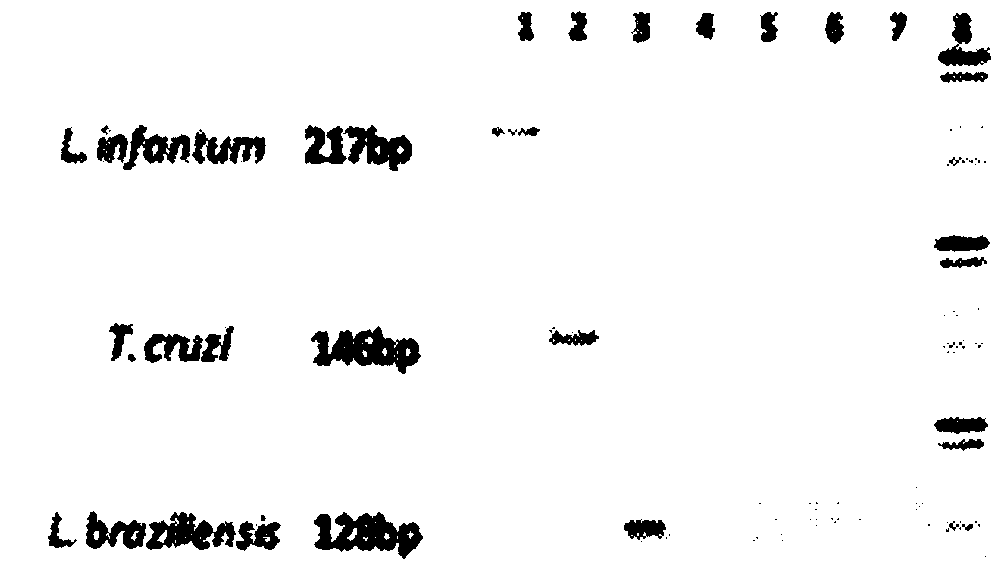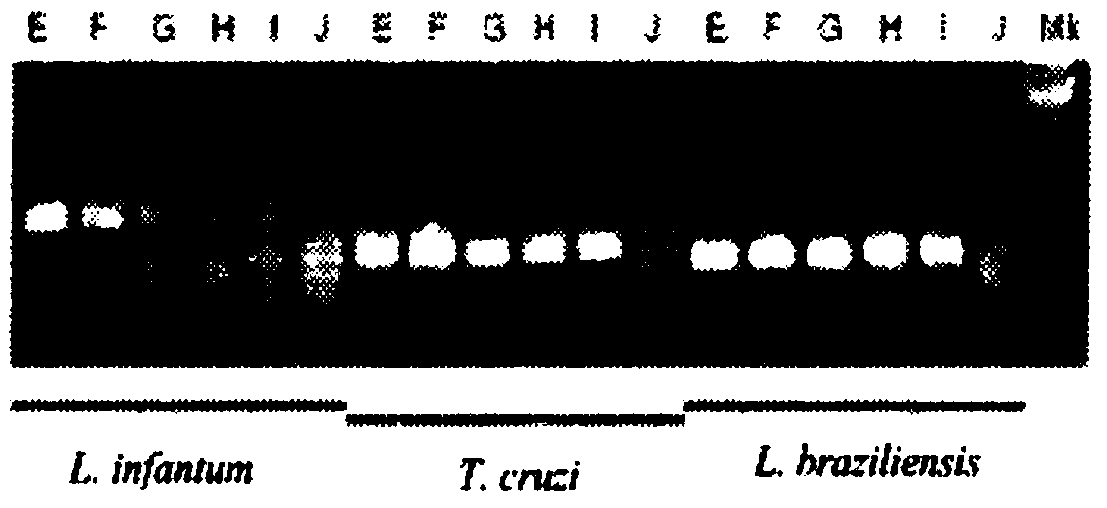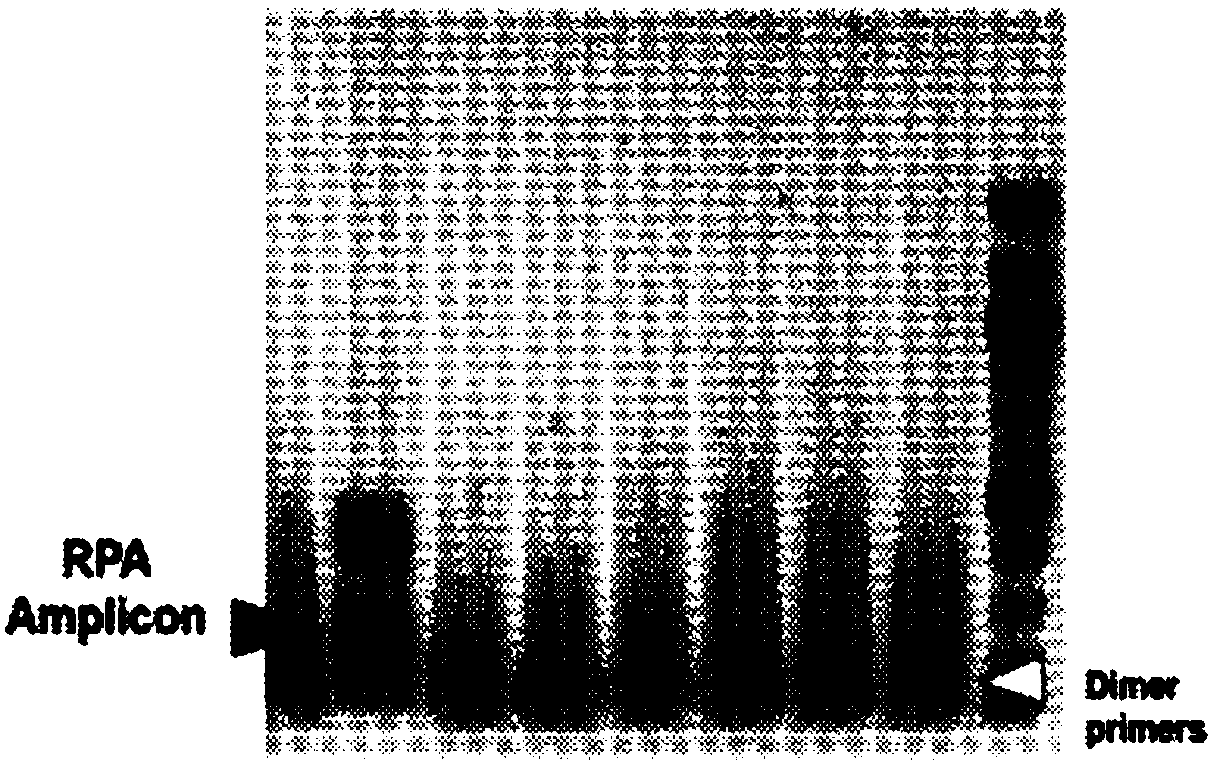Parasite detection kit and detection method thereof
A technology for detection kits and detection methods, applied in biochemical equipment and methods, measurement/testing of microorganisms, DNA/RNA fragments, etc.
- Summary
- Abstract
- Description
- Claims
- Application Information
AI Technical Summary
Problems solved by technology
Method used
Image
Examples
Embodiment 1
[0048] A parasite detection kit, such as Figure 1-5 As shown, amplification primers or RPA primers specifically amplify specific parasites to generate parasite-specific amplicons. Probes and amplicons are specific for amplifying Leishmania donovani, Leishmania chagasi, and Leishmania infantum. These parasite-specific amplicons were detected with oligonucleotide probes. Probes are specifically designed to target unique DNA sequences and are amplified by two primers. The combination of primers and probes determines the specificity (the DNA sequence to be detected) for the test. In certain aspects, the Leishmania donovani, Leishmania chagasi, Leishmania infantum specific amplification primer comprises an oligonucleotide sequence having 90%, 95%, 98% or 100% identity, an oligonucleotide The nucleotide sequence includes SEQ ID NO: 3, 4, 5, 6, 7, 8, 10, 11, 12, or 13. Amplification primers include: 25, 26, 27, 28, 29, 30, 31, 32, 33, 34, 35, 36, 37, 38, 39, 40, 41, 42, 43, 44, ...
Embodiment 2
[0051]Primers, probes and amplicons are specific for the amplification of Leishmania brasiliensis. Oligonucleotide probes were used to detect these parasite-specific amplicons. The Leishmania brasiliensis amplification primers include 70, 75, 80, 85, 90, 95, 98 or 100% identical oligonucleotide sequences, and the oligonucleotide sequences include SEQ ID NO: 16, 17, 18, 19, 20, 21. In certain aspects, amplification primers include: , 45 consecutive oligonucleotides. Certain aspects relate to amplification primer pairs comprising SEQ ID NO: 16 / 19, 16 / 20, 16 / 21, 17 / 19, 17 / 20, 17 / 21, 18 / 19, 18 / 20, or 18 / 21. The oligonucleotide of the nucleotide sequence included in the RPA probe is SEQ ID NO:77.
Embodiment 3
[0053] Primers, probes and amplicons are specific for the amplification of the trypanosoma trypanosoma trypanosoma or trypanosoma rangeli. Oligonucleotide probes were used to detect these parasite-specific amplicons. In certain aspects, the Trypanosoma cruzi amplification primers comprise 90, 95, 98 or 100% identical oligonucleotide sequences comprising SEQ ID NO: 23, 24, 25, 26, 27, 28 . Amplification primers include: having 25, 26, 27, 28, 29, 30, 31, 32, 33, 34, 35, 36, 37, 38, 39, 40, 41, 42, 43, 44 or 45 consecutive Oligonucleotides. Certain aspects relate to amplification primer pairs comprising SEQ ID NO: 23 / 26, 23 / 27, 23 / 28, 24 / 26, 24 / 27, 24 / 28, 25 / 26, 25 / 27, or 25 / 28. The RPA probe may comprise an oligonucleotide having the nucleotide sequence of SEQ ID NO: T. rangeli trypanosoma or SEQ ID NO: 29,30.
PUM
| Property | Measurement | Unit |
|---|---|---|
| Dilution degree | aaaaa | aaaaa |
Abstract
Description
Claims
Application Information
 Login to View More
Login to View More - R&D
- Intellectual Property
- Life Sciences
- Materials
- Tech Scout
- Unparalleled Data Quality
- Higher Quality Content
- 60% Fewer Hallucinations
Browse by: Latest US Patents, China's latest patents, Technical Efficacy Thesaurus, Application Domain, Technology Topic, Popular Technical Reports.
© 2025 PatSnap. All rights reserved.Legal|Privacy policy|Modern Slavery Act Transparency Statement|Sitemap|About US| Contact US: help@patsnap.com



